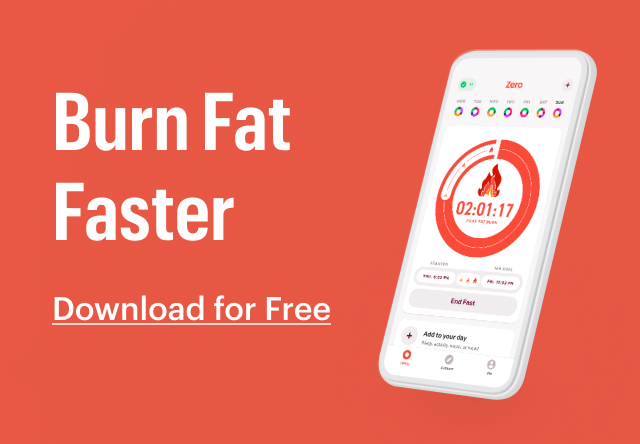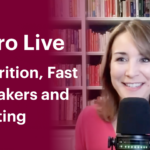Written and medically reviewed by Katya Meyers, RD
Consistently logging 12–18-hour fasts is the best way to lose weight, burn fat, and improve your metabolic health. So if you’re already fasting regularly with Zero, congratulations! You’ve taken the most important first step towards weight loss and health gain.
If you’re looking to take the next steps on your journey, it’s time to examine your activities before you begin and after you end each fast. Of course, there’s no such thing as a shortcut when it comes to improving your health, but what you do just before starting your Timer and just after the Timer goes off can help you reach your goals more quickly and with less effort. We call this “bookending” your fasts, and it can be the wind at your back when it comes to losing weight and achieving metabolic health.

What Does “Bookending” Your Fasts Mean?
Bookending your fasts refers to what you do, and especially what you consume, just before and after a fast. Fasting — i.e., limiting when you eat — is certainly the number-one priority, but there’s no denying that what you eat during your eating window matters, too. The good news is that your “bookend” meals — the pre-fast meal and the post-fast meal — play an outsized role when it comes to improving the results of your fast. By getting just these two meals right, you can make quicker progress towards your goals.
When you choose the right pre-fast meal, it helps your body switch into Fat-Burning Mode more quickly. Not only does this mean your body spends more time each day burning fat, but you’ll experience fewer cravings or energy crashes that can make fasts feel difficult. Likewise, the right Fast-Breaker meal can help keep your blood sugar stable as you begin your eating window. By avoiding a post-fast blood-sugar spike, you’ll consequently avoid the blood-sugar crash that can turn you “hangry,” and you’ll have an easier time making healthy food choices throughout the day.
3 Considerations for Your Pre-Fast Meal
So, what should you nosh on just before setting your Timer? A modestly sized, balanced meal with a good source of protein, high-quality fats, and complex carbs is the way to go.
#1) Choose a Smaller Dinner Plate
Dinner is typically the final pre-fast meal, and while you don’t want to go to bed hungry, resist the temptation to overfill your plate in an effort to “stockpile” calories in advance of a fast. Not only can this make you physically uncomfortable, it can have a negative effect on your sleep.
One well-controlled study found that increased calories and sugar intake were associated with lighter, less restorative sleep and more middle-of-the-night wakeups. If weight loss is your goal, quality sleep is essential because studies show insufficient quality sleep can sabotage weight-loss efforts.
Beyond improving sleep, sticking to a modestly sized Fast-Starter meal helps in reaching fat burning sooner, too. The more quickly you can burn through your final meal of the day, the sooner your blood-sugar and insulin levels will fall and the faster your body can make the switch from burning primarily glucose to burning primarily fat as fuel. This is key to your weight-loss efforts, and it also helps reduce hunger and cravings. A win-win!
Try This: A modestly sized dinner 2–4 hours before bedtime.
Instead of That: A large dinner, followed by an even larger dessert just before your head hits the pillow.
#2) Avoid “Naked” Carbs
A big plate of pasta may be the way to go the night before a very long endurance race, but as a lead-in for your next fast, you’ll want a more balanced approach. Carbohydrates have, by far, the biggest effect on increasing blood-sugar levels, and when your blood-sugar readings look like a series of jagged mountain peaks, you’re likely to experience cravings, energy crashes, and mood swings that make fasting feel harder.
To turn these mountain peaks into gently rolling hills, avoid eating “naked carbs” — i.e., meals that contain primarily carbohydrates without the glucose-stabilizing and digestion-slowing “cover” of protein and healthy fats — especially in your final meal of the day. Put another way, if you ensure your pre-fast meal has a fairly even mix of macronutrients, you’ll experience a more pleasant fast.
The reason this works is because protein is incredibly effective at holding back the blood-glucose-spiking effects of carbs. (Adding protein to a meal reduced average glucose levels by up to 40% in one study!) Meanwhile, a modest amount of healthy fats can also flatten sharp glucose spikes by slowing gastric emptying, which means that the glucose enters your bloodstream at a slower, more even rate.
Try This: Fatty fish (salmon and mackerel), grass-fed beef, eggs, chicken, and nuts.
Instead of That: Carbohydrate-heavy meals that lack sources of protein or healthy fats — for example, plain pasta, rice, or bagels.
#3) Go for the Slow Burn
In addition to including protein and fat with your carbohydrates, it’s important to choose the “right” type of carb.
When it comes to carbohydrates, not all carbs are created equal. They can be divided into fast-acting, simple carbohydrates and slow-burning, complex carbohydrates. Simple carbohydrates are composed of one or two sugar molecules and include foods such as white breads, table sugar, fruit juice, sodas, and honey. These carbohydrates are quickly and easily utilized by your body for energy and cause a rapid rise in blood sugar and insulin secretion.
Complex carbohydrates, on the other hand, contain three or more sugars bonded together into a complex structure that takes longer to digest, thereby causing a more gradual increase in blood sugar. Foods like starchy vegetables and whole grains provide this slow release of sustained energy. When it comes to carbohydrates, particularly for your pre-fast meal, slow and steady win the race.
Try This: Sweet potatoes, steel-cut oats, legumes, peas, berries, apples, and citrus fruits.
Instead of That: Refined grains such as white breads and pastas, cakes, candy, and sugar-sweetened beverages.
Putting It All Together
So, what does this look like “on your plate?” Combining a modest amount of your favorite high-protein foods (chicken, beef, tofu, or plain Greek yogurt) with a healthy fat (avocado, nuts, olive oil, butter, coconut milk, dark meat, or fatty fish) and your favorite non-starchy veggies (broccoli, kale, carrots, squash) is the most straightforward way to start.
A few examples:
- Zucchini noodles with grass-fed beef meatballs
- Salmon, wild rice, and sautéed veggies
- Vegetable stir-fry with tofu and cashews
- Full-fat Greek yogurt with berries and nut butter
3 Considerations for Your Fast Breaker
When planning your first post-fast meal, the first thing you need is… a plan. Having stocked your fridge or pantry with healthy options can make a world of difference in how you break your fast. So, what foods should you have on hand? Fortunately, this list includes many of the same items as your pre-fast meal: quality proteins, vegetables, and fruits.
#1) Eat Plenty of Protein
When breaking your fast, protein should be the star of the show. In addition to stabilizing blood-sugar levels, protein has a satiating effect that can help you make smarter food choices as you enter your eating window. Also, the essential amino acids found in high-protein foods can help rebuild and repair your body’s tissues and facilitate muscle growth by turning on IGF-1 and mTOR pathways that are temporarily deactivated during a fast.
Additionally, as far as macronutrients go, protein is a bit of a power player, since the thermic effect of protein means that, gram for gram, your body uses more energy (i.e., burns more calories) breaking down protein than any other food source. And, as if that’s not enough, eating a high-protein diet can also help your body preserve lean mass as you age, even during a calorie deficit. This means that when your body sheds mass, it’ll be fat, not muscle.
Try This: Chicken, eggs, lean beef, lentils, and cottage cheese.
Instead of That: Low-protein foods.
#2) Choose Lower-Glycemic Foods
Many of the same carbohydrate principles that guide your Fast-Starter meal apply here, as well. Essentially, you want to eat in ways that avoid spiking your blood sugar — and this can be even more challenging if you just completed a longer fast (which can reduce insulin sensitivity) or if you break your fast first thing in the morning, when fasting blood-sugar levels are naturally higher (a phenomenon known as the “dawn effect”). The best way to keep your blood sugar stable is to attend to the glycemic index of the foods you eat in your Fast-Breaker meal.
Glycemic index is a measure used to track how quickly foods increase blood-sugar levels upon consumption. Low-glycemic foods (55 or less, on a scale of 0–100) produce a gradual increase in blood sugar. These foods include low-carbohydrate foods such as eggs and nuts, all non-starchy vegetables (think: the ones you can enjoy raw that pack a crunch!), steel-cut oats, whole grains, and most fruits. High-glycemic foods are things like table sugar, maple syrup, soft drinks, fruit juice, and refined grains.
Resisting the urge to break your fast with sugary treats — donuts, pastries, or even many breakfast cereals — can help lock in the positive benefits of the fast you just finished and extend your time in Fat Burning. If you do plan to indulge, wait until a little later in the day (a post-lunch treat, for example).
Try This: Cottage cheese, eggs, berries, apples, Greek yogurt, steel-cut oats, and non-starchy vegetables.
Instead of That: High-glycemic carbohydrates such as white breads, donuts, and fruit juice.
#3) Support Your Microbiome
In many respects, you can think of fasting as “spring cleaning” for your gut — it reduces harmful strains of bacteria and boosts the activity of beneficial ones, thereby improving your microbiome composition. A healthy microbiome has been associated with a long list of health benefits, from better metabolic health to lower rates of irritable bowel syndrome (IBS). Including fermented foods in your diet can further help balance your microbiome by increasing the number of beneficial bacteria.
But it’s not enough to just repopulate your gut. The beneficial bacteria in your gut thrive off of high-fiber foods like fruits, vegetables, and whole grains. So, emphasize these in your Fast Breaker, and avoid ultra-processed foods, which can lead to changes in gut microbiota that may increase your body’s inflammatory response (which, in turn, is linked to obesity and various chronic diseases).
Try This: Yogurt, kimchi, sauerkraut, and kefir, as well as plenty of fruits and vegetables
Instead of That: Low-fiber, ultra-processed foods including most packaged items like chips and crackers
Putting It All Together
So, what are some examples of a good Fast Breaker? Some options include:
- An omelet with spinach and mushrooms
- Steel-cut oats with blueberries, walnuts, and protein powder
- A green smoothie with kale, berries, flax, nut butter, and your milk of choice
What Else Can You Do Before and After a Fast to Accelerate Fat Burn and Weight Loss?
Fasting regularly and bookending your fasts with high-quality foods has you off to a great start! If your goal is to do even more to accelerate fat burn and weight loss, there are complementary habits that you can employ. And no, you don’t have to do them all at once! Choose one or two from the list and practice until they’re a regular part of your routine.
Log with Zero
Consistency is the most important principle of a successful weight-loss and fat-loss journey. No matter where you are on your journey, Zero can provide the motivation, education, and accountability you need to build and maintain your fasting habit and as well as other activities that improve your metabolic health.
Amp Up the Movement
Even if you’re not ready for a new gym membership and all-out workout routine, reducing the amount of time you spend sitting each day can have an outsized effect. With the exception of competitive athletes involved in high-intensity training, the majority of people burn most of their calories in non-exercise endeavors like walking to work, yardwork, and even breathing. So the goal is to do more such activities, and for longer! A recent study examining the effect of standing versus sitting after a meal showed that participants increased the amount of calories they burned by 11% for two hours post-meal when they stood instead of sat.
Eat Early
While the jury is still out, there is mounting evidence that shifting your eating window to earlier in the day can help speed up both weight loss and fat loss. One reason this might work? Eating farther away from bedtime enhances your sleep quality. One large-scale study showed that those who ate less than one hour before bedtime experienced lower-quality sleep, including both more wakefulness after sleep onset and shorter sleep duration, than those who gave their meal more time to digest before hitting the hay.
Choose Rewards That Are Not Food-Based
It can be tempting to reward yourself for a job well done with your favorite indulgent foods. However, using food as a short-term reward can backfire in the long term. Research has shown that a common reason people do not lose weight when starting an exercise program, for example, is the tendency to make rewards food-based. Instead, eat to satiate hunger and choose another activity that will give you that dopamine hit: Call a friend, light a scented candle, listen to your favorite playlist, or simply cozy up on the couch with a good book.
Conclusion: The Right Pre- and Post-Fast Meals Can Make Fasting Easier and Weight Loss Quicker
Fasting is the best way to lose weight, burn fat, and gain metabolic health. Bookending your fasts with well-constructed pre-fast and post-fast meals can help you flip the metabolic switch sooner and stay in fat burning longer, allowing your body to use more fat as fuel. This can reduce hunger and cravings, make your fasts feel easier, and help you progress towards weight loss and health gain more swiftly. Emphasize proteins, healthy fats, fermentable foods, and plenty of crunchy veggies and fruits, while minimizing ultra-processed foods, and you’ll be well on your way!
- The Fasting Guide to Menopause, Perimenopause, and Postmenopause - April 8, 2024
- Try This Instead of That: How to Bookend Your Fasts - March 25, 2024
- 60 Names for Sugar: The Myths, The Facts, and What You Should Know - February 12, 2024






